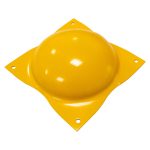Introduction
Parking stops play a crucial role in marking designated parking spaces and preventing vehicles from overstepping their boundaries. When it comes to parking stops, two common options are rubber and concrete. Both serve the same purpose but have distinct differences that make one more suitable for certain situations. In this article, we will compare the advantages of rubber parking stops and concrete parking stops to help you determine which one would be the best choice for your parking lot. We will discuss key factors such as durability, installation, maintenance, safety, cost, and environmental impact to provide a comprehensive comparison. By the end of this article, you will have a better understanding of the benefits of each type and be able to make an informed decision for your parking lot.
Durability
The durability of parking stops is a crucial factor to consider when choosing the right material for your parking lot. In this aspect, rubber parking stops have a clear advantage over concrete parking stops.
Rubber is known for its high durability, making it a reliable option for long-term use. It can withstand extreme temperatures, heavy vehicles, and constant exposure to the elements without cracking or chipping. This makes rubber parking stops a cost-effective investment for any parking lot.
In contrast, concrete parking stops are prone to cracking and chipping over time, especially in areas with harsh weather conditions and heavy traffic. This can lead to the need for frequent repairs or replacements, adding to the overall cost and inconvenience.
Overall, the durability of rubber parking stops makes them a more reliable and low-maintenance option compared to concrete parking stops.
Installation
Installing parking stops is an essential part of creating a well-organized and functional parking lot. When comparing rubber and concrete parking stops, one of the key factors to consider is the installation process.
Rubber parking stops are easier and quicker to install compared to concrete stops. Their lightweight nature makes them easier to transport and position on the ground, and they can be easily anchored with spikes or bolts for a secure installation. On the other hand, concrete parking stops require heavy machinery and skilled labor, which can add to the overall cost and installation time.
In terms of convenience and efficiency, rubber parking stops have a clear advantage. Their simple installation process can save time and money for parking lot owners. It is important to keep in mind the additional equipment and labor required for concrete stops when making a decision.
Maintenance
Maintaining parking stops is crucial to ensuring their longevity and functionality. In this section, we will compare the maintenance requirements of rubber and concrete parking stops.
Unimat Traffic rubber parking stops are low maintenance and require only occasional cleaning with a hose to remove dirt or debris. On the other hand, concrete parking stops may require regular cleaning or repainting to maintain their appearance, which increases the overall cost of maintenance.
Furthermore, rubber parking stops are resistant to staining, while concrete parking stops can become discolored over time. This makes rubber stops a more convenient and cost-effective option in the long run.
In terms of environmental impact, rubber parking stops are also a more sustainable choice as they are made from recycled materials. Additionally, at the end of their lifespan, rubber stops can be recycled again, reducing waste and promoting sustainability.
In conclusion, rubber parking stops require minimal maintenance and offer sustainability benefits, making them a more convenient and eco-friendly option for parking lots.
Safety
When it comes to safety, rubber parking stops have a clear advantage over concrete parking stops. Due to their flexible nature, rubber stops are less likely to cause damage to vehicles in the event of a collision. This not only protects the vehicles but also prevents injury to pedestrians. On the other hand, concrete parking stops can cause significant damage to vehicles and even pose a safety hazard for those walking in the parking lot.
Additionally, the flexibility of rubber parking stops also allows them to absorb impact and reduce the risk of accidents. This is especially important in high-traffic areas where accidents are more likely to occur. By choosing rubber parking stops over concrete, you are prioritizing the safety of your customers and employees.
Cost
In terms of cost, rubber parking stops are generally more affordable than concrete parking stops. Due to their lightweight nature, rubber stops are cheaper to produce, transport, and install. This makes them a cost-effective option for large parking lots. On the other hand, concrete parking stops require heavy machinery and skilled labor for installation, adding to the overall cost and time. Additionally, the potential for damage and wear over time may result in additional maintenance costs for concrete stops. Therefore, when considering the overall cost, rubber parking stops are a more economical choice for parking lot owners. By opting for rubber parking stops, they can save on production, transportation, installation, and potential maintenance costs, making it a wise long-term investment.
Environmental Impact
In addition to their advantages in terms of durability, installation, maintenance, and safety, rubber parking stops also have a positive impact on the environment. Unlike concrete parking stops, they are made from recycled materials, reducing the demand for new resources. Additionally, at the end of their lifespan, rubber stops can be recycled again, further reducing waste. This makes rubber parking stops a sustainable choice for parking lots. On the other hand, concrete parking stops require the use of new materials and have a larger environmental footprint due to their production and installation process. When considering the long-term impact on the environment, rubber parking stops are a more eco-friendly option.
Conclusion
In conclusion, the choice between rubber parking stops and concrete parking stops ultimately depends on the specific needs and priorities of your parking lot. While both types serve the same purpose of marking designated parking spaces, they differ in terms of durability, ease of installation, maintenance, safety, cost, and environmental impact.
Rubber parking stops offer long-term durability, easy installation, minimal maintenance, and safety benefits. They are also more cost-effective and have a lower environmental impact compared to concrete parking stops. On the other hand, concrete parking stops may be a better choice for areas with heavy traffic and harsh weather conditions, but they come with higher installation and maintenance costs.
Therefore, it is important to carefully evaluate these factors and make an informed decision that fits your specific needs and budget. Consider the size and location of your parking lot, the type of vehicles that will be using it, and any potential safety concerns. With the right choice, you can ensure a well-marked and safe parking lot for your customers or employees.





